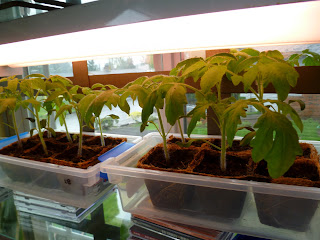 The mixed winter greens an vegetables are behind last year. Radishes, mesclun, spinach, lettuce, and some scallions from seed. They are starting to grow faster now. The chicken wire protect from kitty cat and squirrel doing their gardening. It works. I planted seeds more thinly this year. Less need to think them out now. The green onions have all been eaten. I recommend that everyone who likes early vegetables and loves green onions to grow Egyptian Walking onions. One of the stars of the early vegetable garden. I have many more in the ground. Some of those are too big to eat now, which is good. That means more for later.
The mixed winter greens an vegetables are behind last year. Radishes, mesclun, spinach, lettuce, and some scallions from seed. They are starting to grow faster now. The chicken wire protect from kitty cat and squirrel doing their gardening. It works. I planted seeds more thinly this year. Less need to think them out now. The green onions have all been eaten. I recommend that everyone who likes early vegetables and loves green onions to grow Egyptian Walking onions. One of the stars of the early vegetable garden. I have many more in the ground. Some of those are too big to eat now, which is good. That means more for later.  Another of the barrel planters. "Inch by inch, row by row. Gonna watch my garden grow." Or in this case, "patch by patch." If I get ambitious I'll add tops to the barrels. That will let in light and warm them up more. That's if I get ambitious.
Another of the barrel planters. "Inch by inch, row by row. Gonna watch my garden grow." Or in this case, "patch by patch." If I get ambitious I'll add tops to the barrels. That will let in light and warm them up more. That's if I get ambitious. The potato project was described yesterday. Here are some of the other containers.
 The strawberries are growing nicely. Each plant has several leaves. These were the bare root plants that I started 2 months ago. They looked near-death. Every plant survived and grew. I see that some have a few roots above the growth medium. I'll add another inch. Enough to cover the roots. Not enough to cover the crowns. The white spots are crush eggshells. I use them to add calcium.
The strawberries are growing nicely. Each plant has several leaves. These were the bare root plants that I started 2 months ago. They looked near-death. Every plant survived and grew. I see that some have a few roots above the growth medium. I'll add another inch. Enough to cover the roots. Not enough to cover the crowns. The white spots are crush eggshells. I use them to add calcium.
 The strawberries are growing nicely. Each plant has several leaves. These were the bare root plants that I started 2 months ago. They looked near-death. Every plant survived and grew. I see that some have a few roots above the growth medium. I'll add another inch. Enough to cover the roots. Not enough to cover the crowns. The white spots are crush eggshells. I use them to add calcium.
The strawberries are growing nicely. Each plant has several leaves. These were the bare root plants that I started 2 months ago. They looked near-death. Every plant survived and grew. I see that some have a few roots above the growth medium. I'll add another inch. Enough to cover the roots. Not enough to cover the crowns. The white spots are crush eggshells. I use them to add calcium. 








